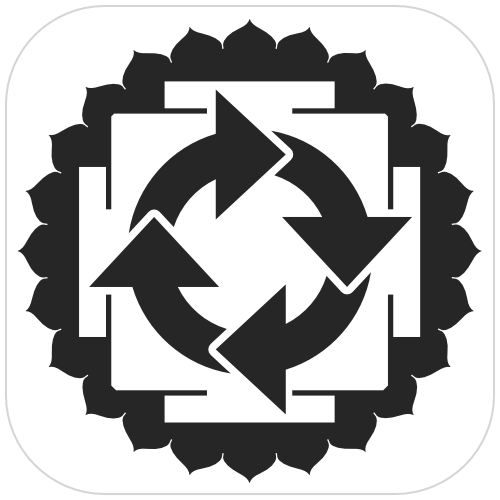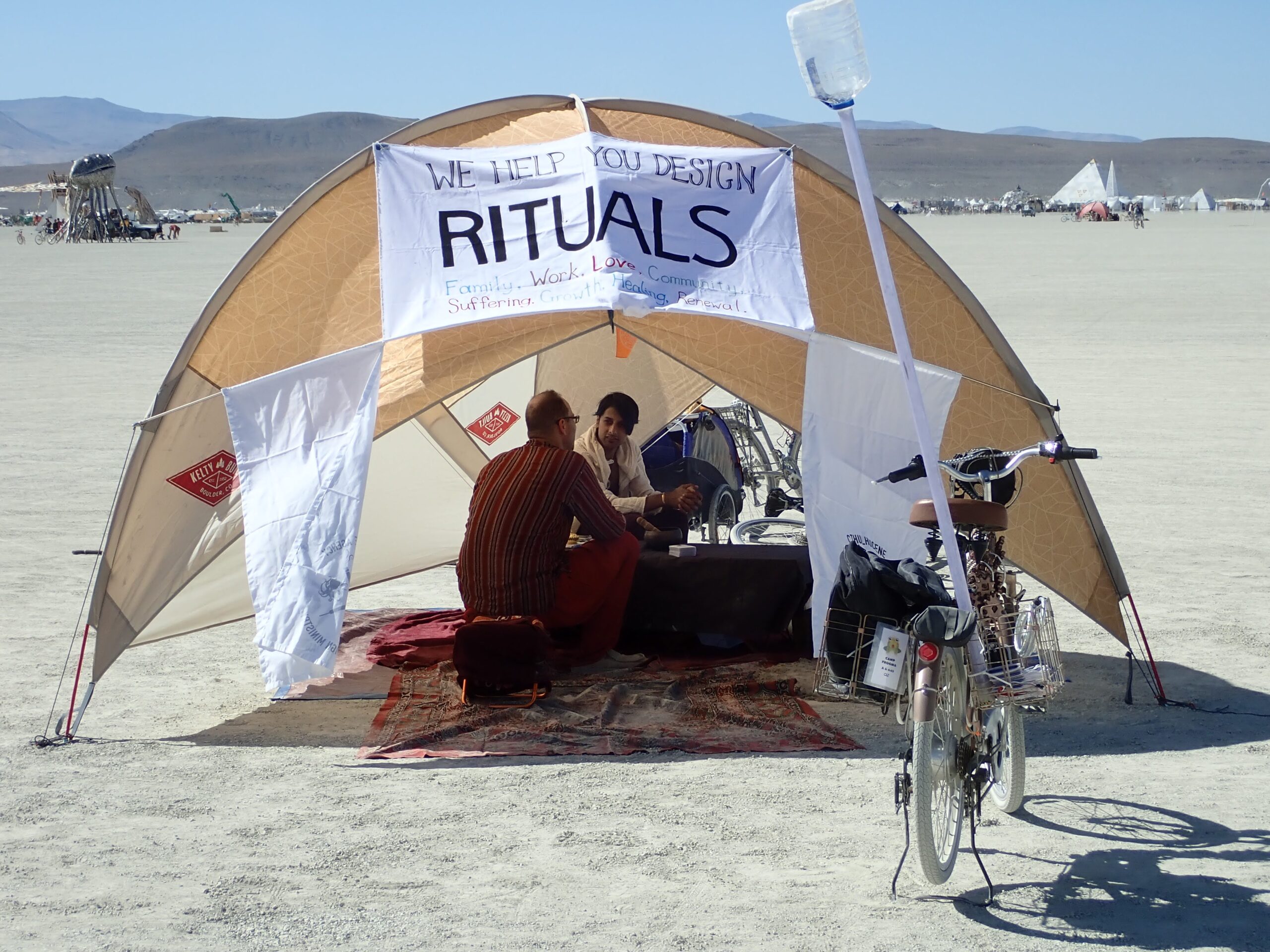We have just got back from hosting a popup studio at Burning Man, and it was a deeply fulfilling and inspiring experience.

Who are we?
We are Adam Menter and Arvind Venkataramani, and we are creators of an open source toolkit for designing secular rituals. Our purpose is to democratize rituals.
We set ourselves up near the Temple…
Originally, we had intended on setting up a portable studio in different parts of the playa every day, but having scouted out the location near the temple we realized it was a really good location. Our purpose aligns well with the Temple’s: provide support for people going through emotionally challenging situations.
The studio consisted of a shade structure in which we set up camp chairs and tables. This gave us a space for hosting conversations, and possibly entering into design if appropriate.


As a happy accident, it turns out that there is no shade structure close to the Temple, so people were drawn to us just because they wanted shade in which to process what they had done or seen at the temple. Some portion of these were intrigued by rituals, or by one of the words on the sign: “family, work, love, community, suffering, growth, healing, renewal”, and came in to talk with us.
Here are some of their stories
- A person was separating from their partner at the same time as they were having a child together, because they didn’t want to have children but had suppressed their needs until they faced the reality of being a parent. We helped him reflect on and see his situation with clarity.
- A family was integrating the loss of a grandfather who’d recently died, and who had wanted to be at Burning Man. They were finding ways to celebrate his life, and keep his spirit with them on the playa and in the life of their child. We gave them space and tools to help deepen a celebration they’d already planned, animating & celebrating his spirit through food.
- Two people whose deeper relationship is only able to fully express itself at Burning Man were looking for ways to carry the “magic of the playa” into their lives, individually and together. We helped them see and work through the dynamics that are keeping the relationship stuck, and also set intentions to craft some experiences at Burning Man to celebrate their time together.




- A person dropped in because they needed a space to process the emotions they had absorbed by spending time in the Temple, and were feeling overwhelmed and didn’t exactly know why. We helped them process, and then designed a small ritual to help them achieve closure and find calm.
- A person had recently started making big changes in their life that their parents were scared of and reacting badly to. They wondered what they could do about it. We helped them frame the situation, and identified a few habits they could put in place to make progress on this.
- A couple were converting their relationship to trans-continental long-distance, and this was beginning at Burning Man. They had different ways of communicating, solving problems, and getting their needs met. We helped create a communication pattern that would meet both of their needs, and identified a way for them to prototype it on the playa.
- A person was constantly second-guessing their decisions. We helped them identify the root of the behavior, and the tensions that were shaping it. We helped them imagine other possibilities, and they came up with mantra they could say to themselves to help deal with the instinct to second-guess. We made a bracelet with the mantra on it for them to wear as a reminder.
These were vulnerable, sometimes scary, and often painful conversations. We found that it took a lot of mental and emotional energy to host these.
“You’ve transformed my week at Burning Man”
We only had the studio running for a few hours in the late morning for a couple of days (more on this later.) The first day, we had so many people come by (and at such constant rates) that it became clear to us that there is a real need in the community — and perhaps the world — for this kind of thing.
So we rapidly prototyped a self-service version.



The table had these instructions on it:
Ring the bell.
You’ve begun a ritual experience at Burning Man.
Open the box, and select a card that speaks to you. Take this card with you, and try to explore the intention written on it as you wander the playa. Bring this card back when you are done.
Reflect on your experience. What did you receive or realize?
While we don’t know exactly how many people dropped by, one person did return a card to us the next day. We didn’t get to talk with them much, so we don’t have a rich description of their experience. We did bump into a small group that was looking for a space to design a ritual of their own, and they found our space just as they left the Temple.
Insights
This work is about more than rituals
We noticed a few different kinds of outcomes from people engaging with us:
- just needing a space for processing and unpacking, with no definite outcome
- identification of beliefs or behaviors to create or change, and designing tools for that (including small, quick, self-initiated rituals)
- designing a ritual, perhaps to be experienced on the fly
It seems that at the heart of this work is holding space for people, and giving of oneself through listening and facilitation. This suggests a broader range of processing experiences adjacent to ritual design could also be made present literally adjacent in a studio space.
There is clearly also a symbolic relationship between this space and the Temple. Perhaps we will find a way to work with the Guardians or the Temple itself. At any rate, there is a clear need for a shade structure near the Temple where people can process and reflect, aided or otherwise.
We need to think about a simple entry/starting point for the ritual design process

Both at Burning Man and in other settings, we found the above structure to be an excellent introductory description of what distinguishes a ritual from a normal action or experience. What this three-circles image does well is to introduce the idea of liminal/ritual vs mundane/world time, and the idea of pathways and transitions. Using Burning Man itself as an example to illustrate our conception of rituals and ritual spaces, we found the most useful learning for people was that they had to pay attention to the opening and closing transitions of any ritual they design.
We also found that the intent cards are an excellent entry point for a variety of purposes — they have been very useful in supporting dialogue and helping people unpack and reflect. However, if this becomes their primary purpose, we will have to expand the intents framework (probably adding categories), and change the language to be more broadly accessible and usable outside a ritual design context. In any case, there is clearly scope for refining the language.
There are a range of studio types we can run
We were able to get the entire studio to fold down and pack into a bike trailer, though we ended up bringing a few more supplies in a second trip.
This was great for a monitored setup, where someone was on hand at all times to make sure everything was in place and not getting blown over by the wind onto the playa. It was not so great for an unmonitored setup, with risk of breakage and an inability to secure items on the table. Were we to do this again, we would like to set up something more permanent and stable. Perhaps something like this lovely contemplation space that also shared the playa with us:

We did commit an error: we did not realize that we could have registered our art-work on-playa, so we returned Thursday morning to find our studio had been very cleanly and professionally removed by one of the BRC organizations! Oops! The playa giveth and the playa taketh away.
But also in true playa fashion it turns out it was handed over to the Temple Guardians, and perhaps it can be re-used next year. At least we know much more about how Burning Man works and how to set things up more sustainably next year.
Join us!
This experience showed that there is a lot opportunity for running popup studios in our own environments. Perhaps we could show up at neighborhood parks or festivals in the Bay Area.
We’d love to have more people able to use the tools to facilitate these sessions. If this sounds interesting, please get in touch!
And perhaps we’ll see you next year on the playa…
Gratitude
Thanks to Sparkadia for hosting us on very short notice and helping Adam and Arvind become playa ready (this was Arvind’s first time and Adam’s second after a gap of a decade). We would not have made it to the playa without them.
Thanks to each person who came by, talked with us, hung out in the space, and shared of their deep and vulnerable thoughts and selves. We are blessed to have had so many chances to see humanity in all its fragility and beauty.
“How can I learn more about this work?”
We’re glad you asked. Head on over to the toolkit website. There, you will find an overview of the toolkit (free to download and use) and a suggested design process to follow. If you’re interested, there’s some background reading.
If you do end up designing a ritual or few, we’d love to hear from you. If you’d like some support in designing a ritual, please reach out. It would be wonderful to create with you.

